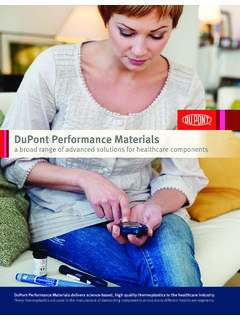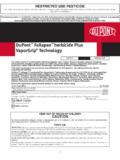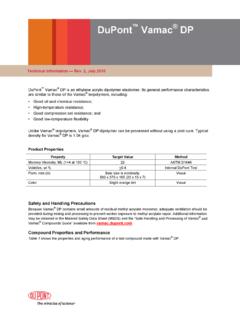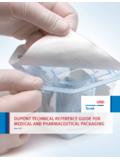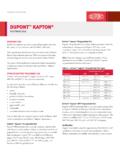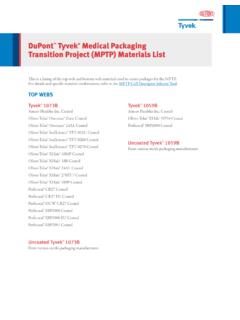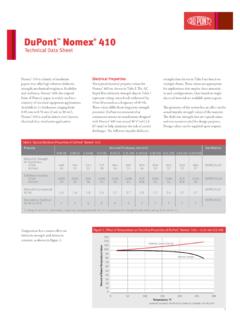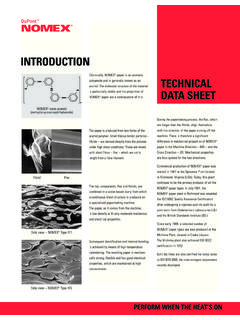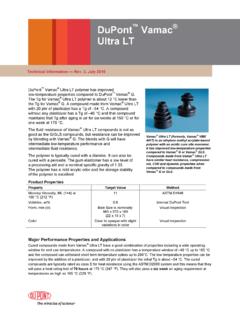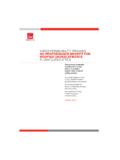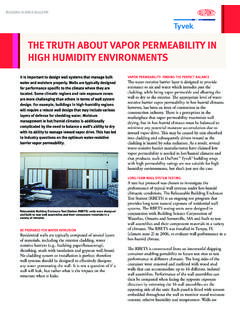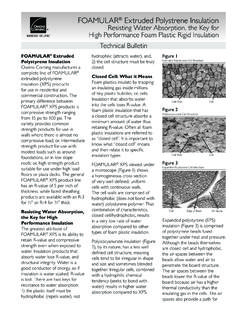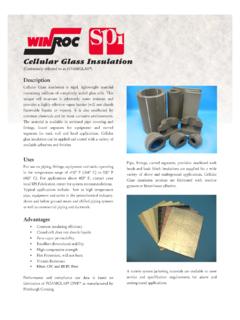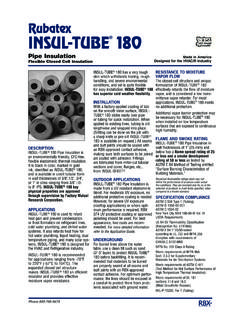Transcription of DUPONT TYVEK VS. TYPAR
1 TECH TALKDuPont TYVEK Water-Resistive Barriers (WRBs) give you the durability and performance needed to build more comfortable and energy-efficient homes. Trusted by quality building professionals everywhere, DUPONT TYVEK Water-Resistive Barriers, part of the complete DUPONT Weatherization Systems offering, deliver superior performance compared to TYPAR and film laminate or coated WRBs as further described in this document. CHOOSING THE RIGHT WRBThe primary purpose of a house wrap is to prevent air penetration and water damage in the wall assemblies of the homes you build. A good WRB must perform four equally important functions:1. It MUST function as an air barrier to help prevent drafts. 2. It MUST provide bulk water resistance to help prevent water that gets behind the exterior cladding from entering into the wall cavity.
2 3. It MUST offer moderate-to-high vapor permeability to allow any water that does enter the wall cavity to It MUST be durable enough to withstand job-site challenges during order to accomplish all of this, a product needs to provide the proper balance of air and water resistance and vapor permeability, and also be strong enough to withstand the rigors of the construction process and perform after TYVEK VS. TYPAR DUPONT TYVEK Water-Resistive Barriers (WRBs) provide superior performance and durabilityDUPONT TYVEK HOMEWRAP ENGINEERED FOR SUPERIOR PERFORMANCEDuPont created TYVEK HomeWrap to have the optimum balance of properties for superior performance against the elements AND the competition. Simply put, TYVEK outperforms TYPAR house wrap due to a fundamental difference in the way the TYVEK WRBs are made.
3 TYVEK HomeWrap is a uniquely engineered product made by spinning extremely fine high density polyethylene (HDPE) fibers that are fused together to form an extremely tough and uniform structure which is continuous throughout the WRB. The fiber structure creates microscopic pores that resist bulk water and air penetration, while allowing moisture vapor to pass through. The performance of DUPONT TYVEK HomeWrap exceeds the International Building Code and the International Residential Code requirements as a water-resistive barrier and meets the air barrier requirements of ICC-ES AC-38 and the ASTM E1677 Standard Specification for a Type I air products are comprised of a thin film coating on a polypropylene fiber mesh. The polypropylene backing consists of a coarse mesh, similar to that of a landscape fabric, which is necessary to provide support for the thin film layer.
4 This mesh is tear resistant but offers no protection for water and air penetration. The thin coating or functional layer is added so minimum water and air resistance standards are TYVEK HomeWrap offers the optimal balance of properties to satisfy all four requirements of a electron micrographs above show that DUPONT TYVEK HomeWrap (left) is uniquely engineered so its functionality extends the full thickness of the product. TYPAR house wraps (right) consist of a thin, functional film coating on a structural mesh. Also, as you can see in the electron micrograph image of TYPAR , the thickness of the functional layer is not a consistent depth. In this particular example, the thickness varied from to microns which is less than half the thickness of a human hair.
5 The thinnest areas tend to occur above the protruding fibers, making these areas even more susceptible to comparison, the entire thickness of TYVEK HomeWrap functions as an air barrier and provides water resistance and is 4 to 20 times the thickness of the functional layer of TYPAR depending on the point at which the functional layer of TYPAR is MATTERS: THE FRAGILE FUNCTIONAL LAYER OF TYPAR IS SUSCEPTIBLE TO DAMAGETo perform as a WRB, TYPAR house wrap relies on a thin layer of film. This functional layer is not an inherently durable material making it prone to damage from the rigors of the job site. In the real word, the film s integrity can be easily compromised through tearing, abrasion, and/or delamination from the support mesh by routine handling both during and after installation.
6 Once damaged, the film layer no longer provides resistance to air and water which are the properties you rely upon to protect the homes you build. IN THE LAB, OR ON THE JOB, TYPAR DOESN T HOLD UP To perform as intended, a WRB must first stand up to the normal rigors of a jobsite and endure common occurrences such as moving ladders, wrapping around corners, installing windows and siding, etc. Even the slightest abrasion, stretching or tearing during any of these jobsite activities can damage the thin functional layer of TYPAR .Abrasion testing, conducted at the request of DUPONT , was used to simulate real world exposure of both TYVEK and TYPAR to the rigors of a typical construction site. Next, TYVEK and TYPAR were tested for air and water resistance. Sample abrasion was conducted per ASTM D3884 on commercially available TYVEK HomeWrap and TYPAR house wrap.
7 The following photographs show samples of both TYVEK HomeWrap and TYPAR before and after only 1 cycle of abrasion which is what you might expect to see after dragging a tool belt across the surface or fitting wood siding into place. After testing, both products showed signs of surface damage as shown in the magnified images that follow. TYVEK HomeWrap Before abrasion testing 8X MagnificationTyvek HomeWrap After 1 abrasion cycle 8X MagnificationTypar house wrap Before abrasion testing 8X MagnificationTypar house wrap After 1 abrasion cycle 8X MagnificationFurther examination using electron microscopy shows that although small fibers are pulled from the surface of TYVEK HomeWrap , the material underneath remains intact. The TYPAR house wrap sample developed holes in the fragile functional layer which compromises the product s ability to hold out air and HomeWrap After 1 abrasion cycle 75X MagnificationTypar house wrap After 1 abrasion cycle 75X MagnificationViewed at 200X Magnification, holes in the funcional layer of TYPAR house wrap appear after just one abrasion cycle, exposing the mesh of Abrasion CyclesHydrohead as Percent of Initial120100806040200 TYVEK HomeWrap TYPAR 02468101214161820 Time (days)Moisture454035302520151050 TYVEK HomeWrap TYPAR Natural OSBTHE IMPORTANCE OF ABRASION RESISTANCE Can minimal surface damage and a few microscopic holes really affect a product s performance ?
8 To find out, both products were tested for air and water resistance after abrasion exposure. All testing was performed using commercially available TYVEK HomeWrap and TYPAR house wrap. The results are clear. TYPAR house wrap lost virtually all of its measurable water resistance after only 1 abrasion cycle. If a WRB cannot effectively hold out water, it will not be able to hold out air. Therefore, minimal abrasion to TYPAR would result in loss of air barrier properties. WATER RESISTANCE AFTER ABRASION (AATCC 127)After as little as 1 cycle, TYPAR lost most of its effective water resistance. The water resistance of TYVEK was not significantly affected after 5 TYPAR relies on this fragile film, it is questionable whether it will withstand the rigors of field installation and site exposure.
9 Film damage has been noted with as little as simple routine handling of the product. TYPAR IS NOT A HIGH VAPOR PERMEABILITY WRB INCREASING POTENTIAL FOR DEVELOPMENT OF MOLD, MILDEW, AND ROTThe low vapor permeability of TYPAR house wrap compared to TYVEK HomeWrap means that it takes longer for a wall to dry, increasing the risk of water-related issues and potential for the development of mold, mildew and rot. The DUPONT Building Science Technical Bulletin Understanding High Perm vs. Low Perm (K-01472) summarizes a study which evaluates the drying rate of saturated OSB samples inside a sealed envelope made of high and low perm WRBs. The envelopes were placed in different temperature & humidity controlled environments to simulate variable climate conditions. The drying behavior of the OSB approaches the natural drying rate when moderate to high vapor permeable WRBs such as TYVEK HomeWrap are used (>20 perms).
10 Lower perm products (<20 perms) such as TYPAR house wrap reduce the natural drying capacity of the OSB. This study was conducted when the perm rating of TYPAR house wrap was and is included as the red line in the figure below. Current literature indicates the perm rating has been reduced to 12 which would further reduce the drying rate. The drying curve of TYVEK HomeWrap closely resembles the drying curve of the natural DRYING CURVES (85 F / 80% RH)This graph illustrates the ability of OSB to dry when covered with TYVEK or TYPAR . TYVEK allows the OSB to dry significantly faster than TYPAR .THE TRUTH ABOUT VAPOR PERMEABILITY IN HIGH HUMIDITY ENVIRONMENTSS everal manufacturers of low perm WRB products, including Fiberweb, the manufacturer of TYPAR house wrap, have claimed that low vapor permeability is needed in hot/humid climates and that products with high permeability ratings are not suitable for high humidity environments, but that s just not the case.

